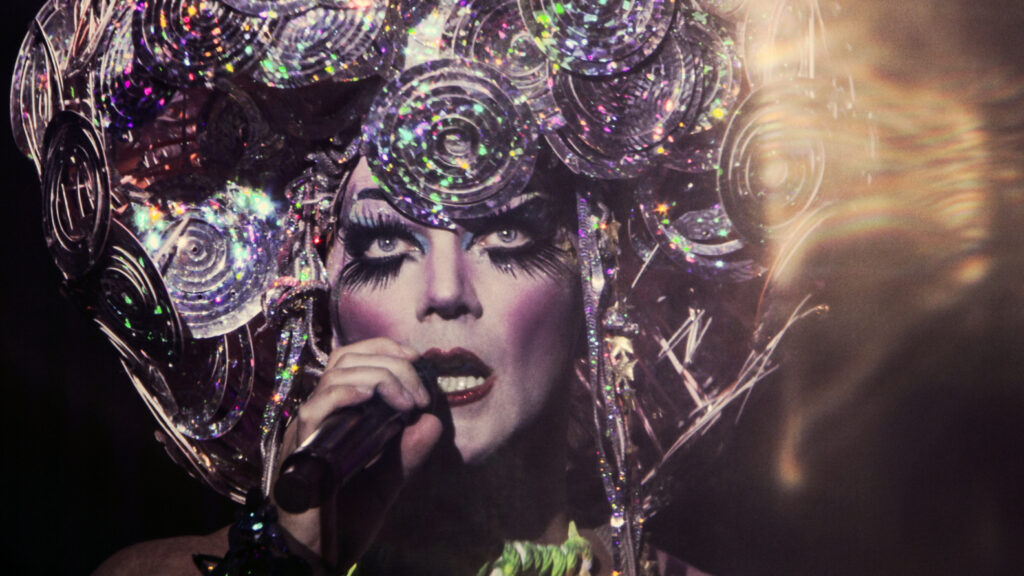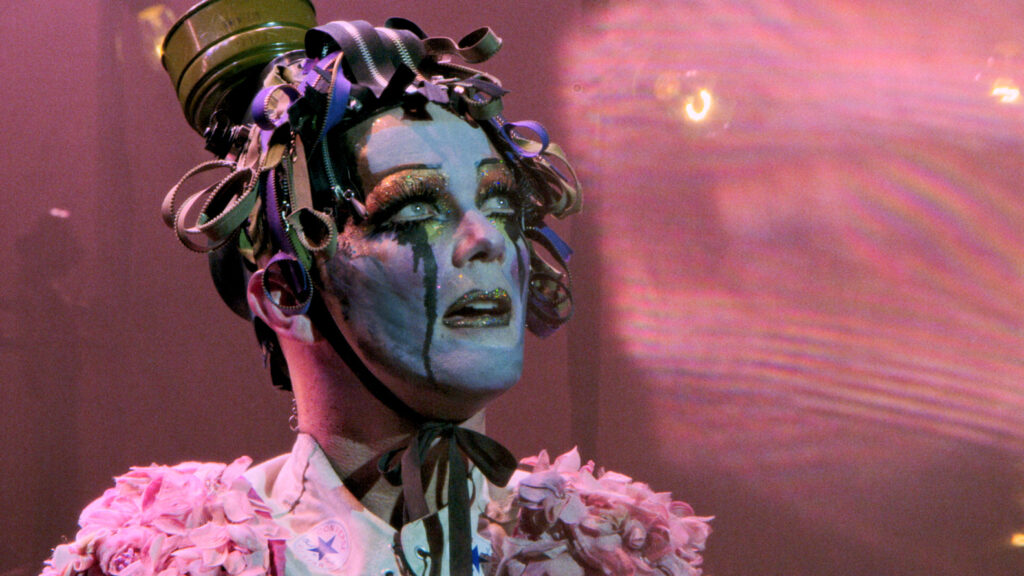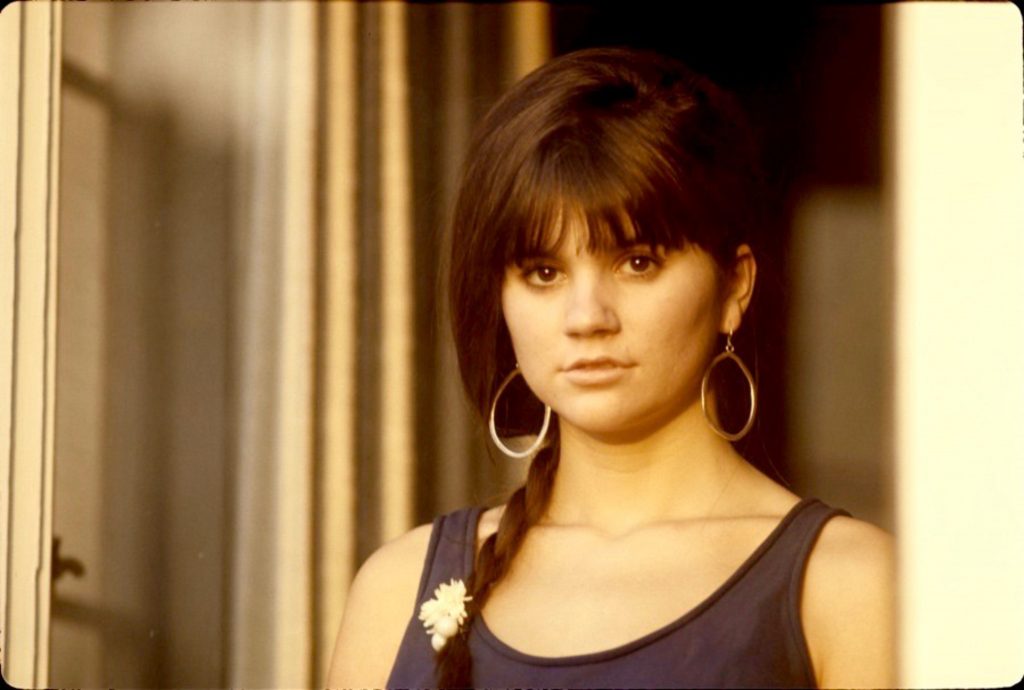June 25, 2023
by Carla Hay

“Taylor Mac’s 24-Decade History of Popular Music”
Directed by Rob Epstein and Jeffrey Friedman
Culture Representation: Taking place mostly in 2016 in New York City, the documentary film “Taylor Mac’s 24-Decade History of Popular Music” features a predominantly white group of people (with some African Americans) who are connected in some way to drag performer Taylor Mac and his one-time-only, 24-hour performance of pop hits.
Culture Clash: During his performance, Mac discusses some of the racism and homophobia behind some of history’s most popular songs.
Culture Audience: “Taylor Mac’s 24-Decade History of Popular Music” will appeal primarily to viewers who are fans of drag performers and music documentaries that focus on unconventional artists and unusual performances.

Vivacious and engaging, this concert documentary starring drag performer Taylor Mac offers a bittersweet presentation of iconic pop songs, without glossing over some of these songs’ problematic histories. It’s an extremely unique 24-hour performance. The 2016 show took place as a one-time-only event, at St. Ann’s Warehouse in New York City’s Brooklyn borough. During this 24-hour continuous performance, Mac performed popular songs from 24 decades (each decade got its own hour), from 1776 to 2016. Attendees had the option to sleep at the venue in a separate room.
Directed by Rob Epstein and Jeffrey Friedman, “Taylor Mac’s 24-Decade History of Popular Music” had its world premiere at the 2023 Tribeca Festival. The majority of the documentary’s footage is of highlights from this epic concert. The rest of the documentary consists of behind-the-scenes footage and interviews with principal members of the events team.
Mac explains in the beginning of the film that he conceived this event as a tribute to those who lost their lives in the AIDS crisis. The show starts with 24 musicians on stage, but after each hour, one less musician goes on stage, until the last hour, when Mac is be the sole performer on stage. The decreasing numbers of band musicians on stage are supposed to be symbolic of how communities and families lost people to the AIDS crisis.
Mac also says in the documentary, “The show is about our history of Americans. That history is in our souls.” He also says that “a queer body can become a metaphor for America.” He later adds, “I learned my politics from radical lesbians.”
Mac gives a brief personal background about himself, by saying that he grew up in Stockton, California, which he describes as a very homophobic city that’s overrun with a lot of “ugly tract houses.” After he graduated from acting school, Mac says that he had difficulty getting auditions. However, he found work at New York City drag nightclubs. And the rest is history.
Some of the key people on the event team also give their perspectives of the show. Niegel Smith, the show’s co-director, calls it a “radical realness ritual” that “asks us to move closer to our queerness.” During one of the audience interaction parts of the show, Mac tells audience members to slow dance with people who are of the same gender. The song selection for this same-sex slow dance is “Snakeskin Cowboys,” a song made famous by Ted Nugent, who is a political conservative. It’s obviously Mac’s way of reclaiming the song and putting it in a progressive queer context.
Matt Ray, the show’s musical director, comes from a jazz background. He says the biggest problem in America is “lack of community.” This 24-hour performance, says Ray, is Mac’s way of trying to bring back community to live events. Machine Dazzle, the show’s costume designer, is seen in costume fittings with Mac, who says that he gave no creative restrictions on how Dazzle could make the costumes. Also seen in the documentary is makeup artist Anastasia Durasova.
It’s no coincidence that the performance starts with the year 1776, since it’s the year of the Declaration of Independence of the United States. Freedom, liberation and fighting against oppression are constant themes throughout the show. During his performances of popular songs from each decade, Mac gives historical context of what was going on in the United States at the time when the song was popular and why some of the songs have a much more disturbing meaning than they seem to have.
“Yankee Doodle Dandy,” performed in the hour covering the years 1776 to 1786, sounds like an upbeat and patriotic song. But Mac also reminds people that during this time, the United States was also built on the enslavement of black people and the destruction of Native Americans. The 1820s song “”Coal Black Rose” has racist origins, since it was originally performed by white people wearing blackface makeup, and the song’s lyrics are about raping an enslaved black woman. For the 1830s song “Rove Riley Rove,” Mac says he’s performing the song to evoke a mother or nanny during the Trail of Tears era, when the Native Americans were forced to go on dangerous and deadly routes when they were forced off their ancestral lands.
Not all of the songs performed have depressing and bigoted histories. When Mac gets to the 1970s decades, he performs songs such as Bruce Springsteen’s “Born to Run” and David Bowie’s “Heroes.” For “Heroes,” which is performed in the context of the Cold War between Russia and the United States, two giant inflatable penises—one with a U.S. flag decoration, one with a Russian flag decoration—float around on stage. Mac straddles at least one of these inflatable sex organs.
Other songs performed in the show include Laura Branigan’s 1982 hit “Gloria” (which Mac interprets in the performance as a sexual liberation song); the Rolling Stones’ 1969 classic “Gimme Shelter”; and “Soliloquy” from the 1945 musical “Carousel,” which Mac was his father’s favorite song. Mac also says that his father died when Mac was 4 years old.
Audience members are encouraged to sing along and participate. And sometimes, Mac invites audiences members on stage during the performance, such as when he selects the oldest person in the room (a man in his 80s) and youngest person in the room (a 20-year-old woman) to dance on stage together. In another part of the show, audience members throw ping pong balls at each other.
Mac doesn’t do all of the lead vocals during the show. There are also guest singers, including Heather Christian, Steffanie Christian, Thornetta Davis, and Anaïs Mitchell. However, there’s no doubt that Mac is the star. He has a charismatic command of the stage, even though he’s not a great singer. He has a wry sense of comedy and keeps the energy level fairly high, even though performing this 24-hour show would be exhausting by any standard.
“Taylor Mac’s 24-Decade History of Popular Music” has a simple concept with an extravagant and very flamboyant presentation. If drag performances and some bawdiness meant for adults have no appeal to you, then watching this documentary might be overwhelming or a little hard to take. The performance in “Taylor Mac’s 24-Decade History of Popular Music” will never be duplicated by Mac, but this memorable documentary is the next best thing to being there.
HBO and Max will premiere “Taylor Mac’s 24-Decade History of Popular Music” on June 27, 2023.

